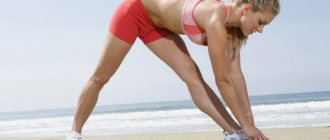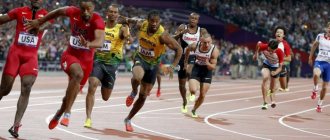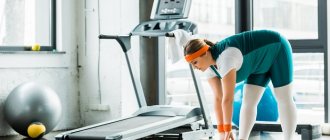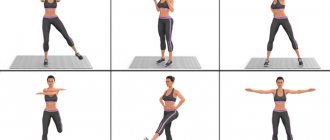Share:
Pull-ups on the bar are an exercise that perfectly develops the latissimus dorsi muscles. Like all vertical rows, especially those performed with a wide grip, pull-ups on the bar primarily increase the width of our upper back, which creates a pronounced athletic silhouette for the athlete. Despite its prevalence throughout the world and its apparent technical simplicity, this exercise is not for everyone. The process of its implementation is not without its pitfalls, which will be discussed today in this article.
Exercise 3. Pull-ups on the bar
(Article: Exercise 3. Pull-ups on the bar)
Hanging with an overhand grip; bending your arms, pull yourself up; straightening your arms, lower yourself into a hanging position.
The hanging position is fixed; when pulling the chin above the bar of the bar.
Hanging on the bar
Pull-ups are performed from a hanging position with straight arms using an overhand grip. It is necessary to pull yourself up so that your chin is higher than the bar; the movement is performed without jerking or swinging movements of the legs.
This exercise is quite simple and familiar to most military personnel. Therefore, it mainly requires the correct structure of training. If preliminary training is required, one lesson is held in which the exercise is performed with assistance (the soldier performing the exercise is supported by the lower leg and thigh by someone providing assistance).
It is advisable to carry out training in performing strength exercises on the crossbar using the repeated method or the maximum effort method. The number of repetitions of the exercise in one approach depends on the level of the current individual indicators of the student, which must be recorded by the commander.
Repetitive training consists of repeating an exercise many times with the same power (the amount of effort should be no more than 60 percent of the maximum).
Training using the maximum effort method is carried out after 3-4 training sessions using the repeated method. In training, when the practitioner performs an exercise with maximum effort, it is sometimes advisable to provide assistance in the final stage of the approach in order to overcome the psychological barrier of a certain number of repetitions. You should not stop at achieving the regulatory requirements of the Manual on Physical Training. It is always necessary to create a reserve of motor abilities, guaranteeing the necessary level of preparedness.
The maximum effort method is characterized by performing exercises in which the soldier exhibits the maximum strength of which he is currently capable. Maximum effort refers to the maximum resistance training weight that a student can lift (perform) without significant emotional arousal. An example of the application of this method can be estimates and checks by the commander of the level of strength development (performing strength gymnastic exercises).
Standards for gymnastics and athletic training
| Exercise | Category of military personnel | Exercise no. | Uniform no. | Units | Military personnel undergoing conscription military service who have served for less than 6 months | Military personnel undergoing conscription military service who have served for 6 months or more | ||||
| ex. | chorus | beat | ex. | chorus | beat | |||||
| Pull-up on the bar | 1 | 3 | 1 1,2,3 | Number of times | 12 | 10 | 7 | 13 | 11 | 9 |
| 3 | 11 | 9 | 7 | 12 | 10 | 8 | ||||
| 4 | 13 | 11 | 8 | 14 | 12 | 10 | ||||
Description of the exercise
The main purpose of the horizontal bar is pull-ups, but you can also perform other exercises on it aimed at developing all muscle groups. A properly designed training program will help you acquire the desired shape and definition.
What muscles are pumped?
Exercising on the crossbar makes it possible to strengthen and tighten your arms, chest, shoulders, back and abs in a short period of time. Exercises on the horizontal bar involve:
- dorsal latissimus muscles, as well as trapezius, rhomboid, orbicularis;
- pectoralis (major and minor muscles);
- serratus anterior muscle;
- shoulder muscles and forearm (biceps, triceps, brachialis, rear deltoid);
- abdominal muscles.
If you follow the technique, the results of your training will be visible within 30 days.
Benefit
The horizontal bar is suitable for both adults and children and has the following effects:
- strengthens the spinal column;
- increases growth;
- stretches the vertebra;
- forms correct posture;
- prevents the occurrence of diseases associated with blood circulation and ailments of the musculoskeletal system.
Regular exercise strengthens your back and prevents scoliosis and vertebral curvature. With the help of exercises, men can pump up their chest, back, shoulders, give them definition, and for women, exercise on the crossbar is useful because it will tighten and strengthen the pectoral muscles, making their bust even more attractive. Professionals can perform one-arm pull-ups on the horizontal bar.
Exercise 4. Raising legs to the bar
(Article: Exercise 4. Raising legs to the bar)
Hanging with an overhand grip; raise your legs to the bar until they touch the bar and lower them down. The hanging position is fixed.
It is advisable to carry out training in performing strength exercises on the crossbar using the repeated method or the maximum effort method. The number of repetitions of the exercise in one approach depends on the level of the current individual indicators of the student, which must be recorded by the commander.
Repetitive training consists of repeating an exercise many times with the same power (the amount of effort should be no more than 60 percent of the maximum).
Training using the maximum effort method is carried out after 3-4 training sessions using the repeated method. In training, when the practitioner performs an exercise with maximum effort, it is sometimes advisable to provide assistance in the final stage of the approach in order to overcome the psychological barrier of a certain number of repetitions. You should not stop at achieving the regulatory requirements of the Manual on Physical Training. It is always necessary to create a reserve of motor abilities, guaranteeing the necessary level of preparedness.
The maximum effort method is characterized by performing exercises in which the soldier exhibits the maximum strength of which he is currently capable. Maximum effort refers to the maximum resistance training weight that a student can lift (perform) without significant emotional arousal. An example of the application of this method can be estimates and checks by the commander of the level of strength development (performing strength gymnastic exercises).
Standards for gymnastics and athletic training
| Exercise | Category of military personnel | Exercise no. | Uniform no. | Units | Military personnel undergoing conscription military service who have served for less than 6 months | Military personnel undergoing conscription military service who have served for 6 months or more | ||||
| ex. | chorus | beat | ex. | chorus | beat | |||||
| Raising legs to the bar | 1 | 4 | 1,2,3 | Number of times | 10 | 8 | 6 | 12 | 10 | 8 |
Safety precautions
Despite its simplicity, exercises on the horizontal bar can be quite traumatic. To avoid injury, you need to remember a few rules. Calluses are a common problem; to avoid them, you need to purchase special gloves or rub your hands with talcum powder. Out of habit, beginners often fall from the horizontal bar; to soften the fall, you should put something soft under the bar. To avoid pain, you need to warm up and take a minimal load before starting.
Exercise 1. Floor exercise set No. 1
(Article: Exercise 1. Floor exercise set No. 1)
Performed on 16 accounts.
The starting position is a combat stance.
Complex of floor exercises No. 1
“One-two” - rising on your toes, slowly raise your arms forward and then up; fingers clenched into a fist, palms inward, look up, stretch.
“Three” - lowering yourself onto both feet, bend your arms forcefully, pressing them to your body, fists to your shoulders, look straight.
“Four” – straighten your arms up, bend over, look up.
“Five” – connecting your toes, squat down to full on your entire foot, palms on your hips, elbows to the sides.
“Six” – straighten up, raising your arms forward and moving them to the sides and back until failure (with a jerk at the end of the movement); fingers clenched into a fist.
“Seven” – squat to failure on both feet, palms on hips, elbows to the sides.
“Eight” – stand up with a jump, legs apart in a wide step, hands on the belt.
“Nine” - straightening your left arm and moving it to the sides and all the way back (fingers clenched into a fist), at the same time turn your torso to the left, do not move your legs, look at your left hand.
“Ten” – turn your torso straight, hands on your belt.
“Eleven” - straightening your right arm and moving it to the side and back until it stops (fingers clenched into a fist), at the same time turn your torso to the right, do not move your legs, look at your right hand.
“Twelve” – turn your torso straight, hands on your waist
“Thirteen” - sharply lean forward until your hands touch the ground, legs straight.
“Fourteen” - straightening up, raise your arms forward and, moving them to the sides and back, bend over.
“Fifteen” – sharply lean forward until your hands touch the ground, legs straight.
“Sixteen” – straightening up, jumping to join your legs and take a combat stance.
Types of pull-ups
You can do pull-ups on the horizontal bar in different ways. Pull-ups can be divided into two groups - on a low and high bar.
On a low crossbar
For the low bar, pull-ups are classified by grip method. It happens:
- straight or upper (palms look parallel to the face of the person pulling up);
- reverse or bottom (hands grab the pipe from below, palms turned towards the athlete’s face);
- neutral or parallel (the hand is turned inward, the palms are opposite).
Horizontal pull-ups on a low bar can be done with either a forward or reverse grip. A straight grip distributes the load equally across all muscles. A wide grip strengthens the back, while a reverse grip works on the biceps and triceps. A narrow grip can strengthen the muscles of the shoulders and forearms.
On a high crossbar
For a high bar, various pull-up techniques are used. Exercises functionally develop the entire muscular system.
CrossFit uses the following types of pull-ups:
- kipping;
- butterfly;
- sternum to tube;
- bouncing.
The exercises are similar to each other; they are performed using inertia. Classic execution techniques require immobility; in CrossFit, the athlete swings and rises above the horizontal bar with inertial movements.
Exercise 2. Floor exercise set No. 2
(Article: Exercise 2. Floor exercise set No. 2)
Performed on 16 accounts.
The starting position is a combat stance.
Complex of floor exercises No. 2
“One-two” - forcefully pull your shoulders and arms back as far as you can, turn your hands clenched into fists, palms forward and, rising on your toes, slowly raise your straight arms up to the sides, unclench your fists, stretch.
“Three” - lowering yourself onto both feet, bend your arms forcefully, pressing them to your body, fists to your shoulders, bring your shoulder blades together, look straight.
“Four” - make a wide lunge to the left with a sharp extension of the arms to the sides and turning the head to the left, unclench the fingers, palms down.
“Five” – push your left leg towards your right and forcefully bend your arms, pressing them to your body; fists to shoulders, shoulder blades close, look straight.
“Six” - make a wide lunge to the right with a sharp extension of your arms to the sides and turn your head to the right, unclench your fingers, palms down.
“Seven” - push your right leg towards your left and forcefully bend your arms, pressing them to your body, fists to your shoulders, bring your shoulder blades together, look straight.
“Eight” – jump with your legs apart in a wide step, arms up, palms together with a clap above your head, and tilt your torso back.
“Nine” – lean forward sharply, hands between your legs, do not bend your legs.
“Ten” – straighten up, raising your arms forward to shoulder height, turn your torso to the left and with a sharp movement spread your arms to the sides to the fullest extent, clench your fingers into a fist, palms forward, do not move your feet.
“Eleven” - without stopping, turn your torso to the right and repeat the forward bend, hands between your legs.
“Twelve” - without stopping, straighten up and repeat the same movement as on the count of “ten”, only with the body turning to the right.
“Thirteen” - without stopping, turn your torso to the left and repeat the forward bend, hands between your legs.
“Fourteen” - straightening up, jumping to bring your legs shoulder-width apart (put your feet parallel) and squat down to failure, arms forward, palms down, fingers unclenched.
“Fifteen” - jump with your legs apart in a wide step, arms up - to the sides with palms inward.
“Sixteen” – jump to join your legs, lower your arms and take a drill stance.
Completion of exercise 1 (2) is assessed:
- “excellent” – if the exercise was performed as described, without errors, easily and confidently, minor errors were made during landing;
- “good” - if the exercise was performed as described, but not confidently enough and with minor errors (incomplete range of motion, slight bending and spreading of the legs, slight bending of the arms and body);
- “satisfactory” - if the exercise was performed as described, but uncertainly and with significant errors (insufficient range of motion, large bending and spreading of the legs, large bending of the arms and body, a stop was made or unnecessary movements were added);
- “unsatisfactory” – if the exercise is not completed or distorted (omission of an element).
Tips for choosing a crossbar
When choosing a horizontal bar, you need to look at:
- what material it is made of;
- what types of grip is it suitable for?
- Are the handles well made?
It is better to give preference to metal products. The ideal option is metal pipes 2-3 cm thick. The hand should tightly grasp the pipe - this is the key to a successful exercise. Each modern horizontal bar provides a lower and upper grip; some models provide a narrow and wide grip. To prevent your hand from slipping and causing calluses, it is better to purchase devices with a rubberized surface.
Kinds
First you need to determine where the crossbar for pulling up the house will be located. For small apartments, a crossbar in the doorway would be an excellent option. If there is enough space in the house, you can install a floor structure. There are various models for a doorway or passage, as well as universal horizontal bars.
They come in three types:
- sliding;
- standard (with anchor fastening);
- removable.
Such devices are compact, but not entirely functional. If there is free corner space, you can install a horizontal bar with anchor fastening in the corner. If space allows, ceiling installation would be a good option. Many people prefer standard hanging horizontal bars. They are easy to install, compact and allow you to do a variety of exercises. Such designs can be purchased in various variations.
Best models
For effective training you will need parallel bars. They are:
- stationary;
- collapsible;
- removable;
- strengthened;
- may have a back and armrest;
- bars combined with a horizontal bar.
The design of these products is quite simple; high-quality and safe materials are used for their manufacture. All devices can withstand loads of up to 150 kg.
The best models include the following devices.
- EffectSport 3 in 1. This is a removable design, attached to a special frame. It is a universal exercise machine that allows you to pump up your chest, back, arms and abs. Refers to mounted structures, made of steel, can withstand up to 150 kg.
- Horizontal bar with a boxing bag. The frame has a special hole for installing a swing or punching bag. This is a fairly simple but effective exercise machine for various muscle groups. It is wall-mounted, can withstand up to 150 kg, and is made of metal and neoprene.
- BradexWorkout. Adjustable, spacer horizontal bar, can withstand up to 90 kg, made of steel and polyurethane.
- EffectSport ceiling crossbar. A very compact device, but not suitable for every room. The steel structure can withstand up to 200 kg.
- Bradex hanging horizontal bar. The device can be used even without attaching it to the wall; it is convenient to swing and do push-ups. The versatility of the crossbar makes it possible to do a variety of exercises. The structure is made of combined materials (metal, foamed polymer and plastic) and can withstand up to 105 kg.
All of these models are among the best on the sporting goods market. They are suitable for an apartment and a gym.









